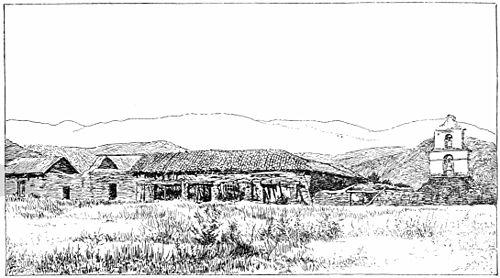nians; though there was a multiplicity of tribes and an abundant population, and hence ample cause for intertribal strife, their warfare was in keeping with the rest of their character, and had in it little of the aggressive fierceness which characterized other Indians to the eastward. No better evidence of their pusillanimous spirits need be required than their abject submission to mission rule, enforced as it was at each mission by the presence of two or three priests and only a half-dozen armed soldiers.

Fig. 2.—Ruins of Branch Mission of Pala, twenty-five miles east of San Luis Rey; established in 1816.
Though the natives of southern California, as the result of living under rather similar conditions of environment, conformed in a general way in physical appearance and in their mode of life, it must not be supposed that there were not very many distinct tribes which differed in many minor particulars. Within the mission area there were scores, if not hundreds, of tribes—just how many we can not tell—and they were divided among no fewer than nine distinct linguistic families. Perhaps the linguistic differences that characterized these tribes formed the most remarkable point of distinction, and it is doubtful if anywhere else in the world within the same area have there ever been observed so many distinct families of language and so many dialects as in California. As Lamanon remarks, "It is the difficulty of learning all the languages that consoles the missionaries for their not knowing any." In point of fact, the language changed dialectically every ten or fifteen miles, while totally distinct linguistic families succeeded each other in bewildering profusion.
The California tribes were in no sense nomadic. That to some extent they changed their place of abode with the season is doubtless true, and in winter the tribes living immediately on
